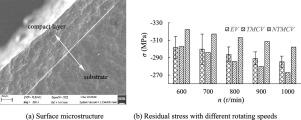当前位置:
X-MOL 学术
›
Int. J. Mech. Sci.
›
论文详情
Our official English website, www.x-mol.net, welcomes your feedback! (Note: you will need to create a separate account there.)
Residual Stresses in High-speed Two-dimensional Ultrasonic Rolling 7050 Aluminum Alloy with Thermal-Mechanical Coupling
International Journal of Mechanical Sciences ( IF 7.3 ) Pub Date : 2020-11-01 , DOI: 10.1016/j.ijmecsci.2020.105824 Hongwei Liu , Jianxin Zheng , Yonglei Guo , Lixin Zhu
International Journal of Mechanical Sciences ( IF 7.3 ) Pub Date : 2020-11-01 , DOI: 10.1016/j.ijmecsci.2020.105824 Hongwei Liu , Jianxin Zheng , Yonglei Guo , Lixin Zhu

|
Abstract In order to achieve the high-efficiency and high-quality anti fatigue manufacturing of 7050 aluminum alloy, high speed ultrasonic machining was introduced into two-dimensional ultrasonic rolling, the simulation and experiment of high-speed two-dimensional ultrasonic rolling (HTUR) 7050 aluminum alloy were carried out. The evolution of temperature field, stress field and strain field in HTUR process were simulated, and the evolution of the surface flow stress with thermal-mechanical coupling was analyzed. The surface residual stress and microstructure of the cross section of sample after HTUR treatment were characterized by X-ray diffraction and scanning electron microscope (SEM). The results show that HTUR treatment can form a gradient strengthened layer and introduce beneficial residual compressive stress in the surface layer of 7050 aluminum alloy. In HTUR process, the surface temperature field, equivalent stress and equivalent strain field are non-uniformly distributed, and the changes of the temperature, equivalent stress and equivalent strain are not completely synchronous with time. The residual stress with thermal-mechanical coupling is slightly less than that of without thermal-mechanical coupling, and close to the experimental results. The temperature has a little negative effect on the residual stress. The performance of the specimen still mainly depends on the cold plastic deformation in HTUR process, so such technology can realize high-efficiency ultrasonic hardening treatment of 7050 aluminum alloy on the premise of ensuring fatigue strengthening.
中文翻译:

热-机械耦合高速二维超声轧制7050铝合金的残余应力
摘要 为实现7050铝合金的高效、高质量抗疲劳制造,将高速超声加工引入二维超声轧制中,对高速二维超声轧制(HTUR)进行仿真与实验。 7050铝合金进行了。模拟了HTUR过程中温度场、应力场和应变场的演化,分析了表面流变应力的热-机耦合演化。通过X射线衍射和扫描电子显微镜(SEM)对HTUR处理后样品横截面的表面残余应力和微观结构进行了表征。结果表明,HTUR处理可以形成梯度强化层,并在7050铝合金表层引入有益的残余压应力。在HTUR过程中,表面温度场、等效应力和等效应变场分布不均匀,温度、等效应力和等效应变的变化与时间不完全同步。热机耦合的残余应力略小于热机耦合的残余应力,与实验结果接近。温度对残余应力的负面影响很小。试样的性能仍然主要取决于HTUR工艺中的冷塑性变形,
更新日期:2020-11-01
中文翻译:

热-机械耦合高速二维超声轧制7050铝合金的残余应力
摘要 为实现7050铝合金的高效、高质量抗疲劳制造,将高速超声加工引入二维超声轧制中,对高速二维超声轧制(HTUR)进行仿真与实验。 7050铝合金进行了。模拟了HTUR过程中温度场、应力场和应变场的演化,分析了表面流变应力的热-机耦合演化。通过X射线衍射和扫描电子显微镜(SEM)对HTUR处理后样品横截面的表面残余应力和微观结构进行了表征。结果表明,HTUR处理可以形成梯度强化层,并在7050铝合金表层引入有益的残余压应力。在HTUR过程中,表面温度场、等效应力和等效应变场分布不均匀,温度、等效应力和等效应变的变化与时间不完全同步。热机耦合的残余应力略小于热机耦合的残余应力,与实验结果接近。温度对残余应力的负面影响很小。试样的性能仍然主要取决于HTUR工艺中的冷塑性变形,


























 京公网安备 11010802027423号
京公网安备 11010802027423号